- Odessa College (OC) Global provides educational opportunities to anybody anywhere at anytime. It offers accredited completely online degree programs, but with access to real-life faculty and staff to help you be successful. Students can learn more about their educational opportunities by taking advantage of the new Wrangler Express Center, OC's new one-stop-shop customer service center. Odessa College will lead the way in preparing its students and community for the future. The College offers exemplary courses, programs, and services to assist students in achieving their educational goals and becoming lifelong learners, community builders, and global citizens. Odessa College empowers its employees to model excellence in their service to students, colleagues, and community.
School Highlights
Odessa College serves 11,985 students (40% of students are full-time).
The college's student:teacher ratio of 28:1 is higher than the state community college average of 23:1.
Minority enrollment is 78% of the student body (majority Hispanic), which is more than the state average of 74%.
Quick Stats (2025)
- Enrollment: 11,985 students
- In-state tuition: $3,900
- Out-state tuition: $5,160
- Student:teacher ratio: 28:1
- Minority enrollment: 78%
- Source: Integrated Postsecondary Education Data System (IPEDS)
Top Rankings
Odessa College ranks among the top 20% of public schools in Texas for:
Category
Attribute
Community Size
Completion Rates
Debt For Students
School Overview
The teacher population of 434 teachers has stayed relatively flat over five years.
Odessa College
(TX) Community College Avg.
Carnegie Classification
Associate's Colleges: Mixed Transfer/Career & Technical-High Nontraditional
Baccalaureate/Associate's Colleges: Associate's Dominant
Institution Level
Four or more years
At least 2 but less than 4 years
Institution Control
Public
Private, for profit
Total Faculty
434 staff
262 staff

School Calendar
Student Body
The student population of Odessa College has grown by 75% over five years.
The student:teacher ratio of 28:1 has increased from 16:1 over five years.
The Odessa College diversity score of 0.57 is less than the state average of 0.70. The school's diversity has grown by 15% over five years.
Total Enrollment
11,985 students
1,396 students

Student : Teacher Ratio
28:1
23:1
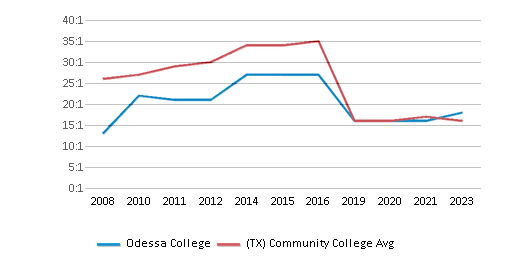
# Full-Time Students
4,846 students
890 students
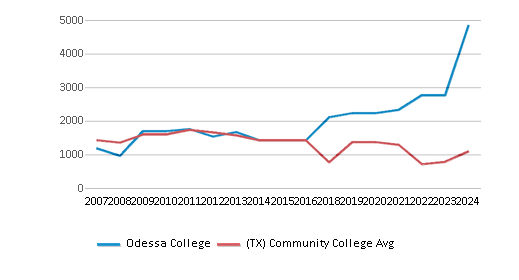
# Part-Time Students
7,139 students
4,022 students



# Enrollment Undergraduate
119 students
403 students
# Full-Time Undergraduate Students
4,846 students
890 students

# Full-Time Graduate Students
n/a
40 students
# Part-Time Undergraduate Students
7,139 students
4,022 students
# Part-Time Graduate Students
n/a
47 students
Total Dormitory Capacity
236 students
252 students

% American Indian/Alaskan
n/a
n/a

% Asian
1%
6%
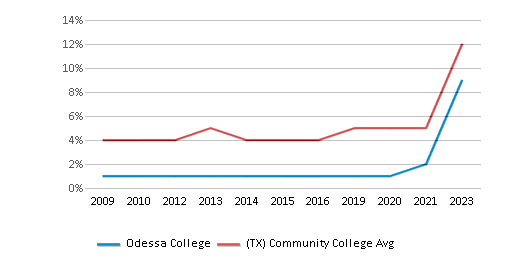
% Hispanic
61%
46%

% Black
8%
14%

% White
22%
26%

% Hawaiian
n/a
n/a

% Two or more races
n/a
3%

% Non Resident races
n/a
2%

% Unknown races
6%
3%


Diversity Score
0.57
0.70
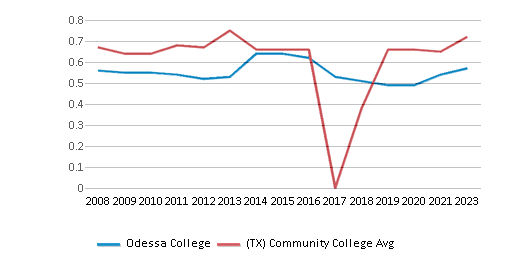
College Completion Rate (Students who graduate in less than 4 years)
4%
0.5469%

College Completion Rate (Students who graduate in 4 years or more than 4 years)
0.2346%
0.3357%
Average Graduate Earnings (10 Years)
$38,400
$34,600

Tuition and Acceptance Rate
The public in-state tuition of $3,900 is more than the state average of $3,316. The in-state tuition has grown by 11% over four years.
The public out-state tuition of $5,160 is less than the state average of $5,750. The out-state tuition has grown by 17% over four years.
In-State Tuition Fees
$3,900
$3,316

Out-State Tuition Fees
$5,160
$5,750

% Students Receiving Some Financial Aid
68%
84%

Median Debt for Graduates
$8,000
$10,765
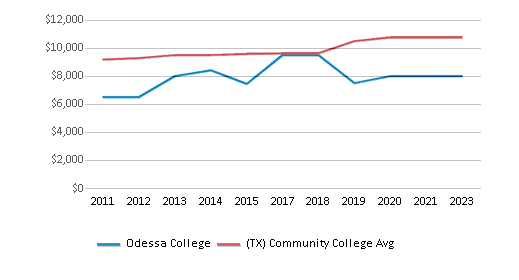
Median Debt for Dropouts
$5,660
$5,500

Acceptance Rate
n/a
81%
Source: 2024 (or latest year available) Integrated Postsecondary Education Data System (IPEDS)
School Notes
- Beginning with 184 students in 1946, OC has grown steadily through the last 54 years. Approximately 5,000 students are enrolled in university-parallel and occupational/technical credit courses. During a year, almost 11,000 individuals also enroll in one or more Adult Basic Education, Continuing Education or Community Recreation courses. Many university-parallel courses are offered for students planning to complete four-year degrees at senior colleges or universities and are freely transferable. Former OC students have a phenomenal record of success in the fields of accounting, law, medicine, music, public administration and teaching. More than 30 occupational/technical programs also are offered, and additional ones are planned to meet the needs of citizens who want to learn new or improve existing skills. With more than 30 percent of our students enrolled in occupational/technical programs, OC continues to fulfill the workforce demands of our community. The campus grew to 15 buildings on a 35-acre plot by 1960. Then during the 1990's, OC received three major property donations as the college continued to expand to serve the educational needs of its students and service. Located in nearby Gardendale, Texas, the 120-acre ranch, now called the Odessa College Rodeo and Agriculture Graham Center, was donated for the enhancement of the Odessa College Rodeo Team and for the development of programs for students majoring in agriculture. Odessa College is accredited by the Commission on Colleges of the Southern Association of Colleges and Schools to award associate degrees.
Frequently Asked Questions
How much does Odessa College cost?
Odessa College's tuition is approximately $3,900 for In-State students and $5,160 for Out-State students.
What is Odessa College's ranking?
Odessa College ranks among the top 20% of community college in Texas for: Largest student body, Highest completion rates and Least debt for graduating students.
Recent Articles

Unlocking Airport Career Opportunities: Your Guide to Ground Jobs
Discover the diverse range of ground jobs at mid-size U.S. airports, their educational requirements, and how community colleges can prepare you for these exciting careers.

Careers: Dental Hygienist, Medical Lab Technician & More Healthcare Positions
Considering the healthcare field? Your community college can equip you for any number of healthcare positions, including Dental Hygienist, Medical Lab Technician, and more.

How To Craft the Perfect College Admissions Essay
Read on to learn the ins and outs of crafting the perfect college application essay.













